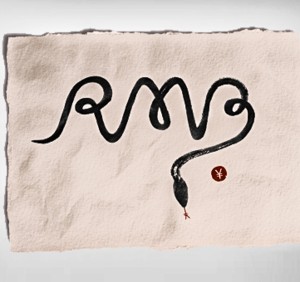
The year of the snake on the Chinese calendar has inspired HSBC to a slick advertising campaign with an arresting image: a brush-painted black snake.
The constrictor’s long body is shaped into the western letters RMB, its bright red tongue into ¥. ‘Discover how HSBC can help you embrace the RMB’ the teaser reads.
This arresting image appears on some internet pages of the Mar. 23 New York Times. It links to a site that makes plain HSBC’s message: ‘In the future, 2013 will be seen as the year of the renminbi’, the year of the Chinese currency (RMB).
For the less sophisticated amongst the Times audience, the unpronounceable ‘renminbi’ has become the ‘yuan’. That is not entirely wrong. Randall Mah on EmergingMoney.com explains why:
Both terms are transliterations from Mandarin. Renminbi, which translates as the “people’s money,” is the official name given to the currency by China’s communist government.
Given that the country’s formal name is the People’s Republic of China, renminbi gives the currency a more egalitarian air.
On the other hand, yuan, which can be translated as “dollar,” is the unit of currency.
Britain’s currency provides a good comparison. While sterling is the name of Britain’s currency, the pound is the unit. Consequently, in the same way you would say, “The jacket costs 100 pounds,” you would also say, “The pants cost 500 yuan.” [Link as in original]
The Chinese Yuan and the Japanese Yen share the symbol: ¥. Just like the Canadian dollar and the American dollar: $.
The black RMB constrictor’s probing tongue, its forked ¥ tongue, carries a sinister, threatening message to American viewers probably not intended by the British bank known once as the Hongkong & Shanghai Banking Corporation (HSBC).
It’s not usually the mammal who embraces such snakes but the other way round.
Recent Comments